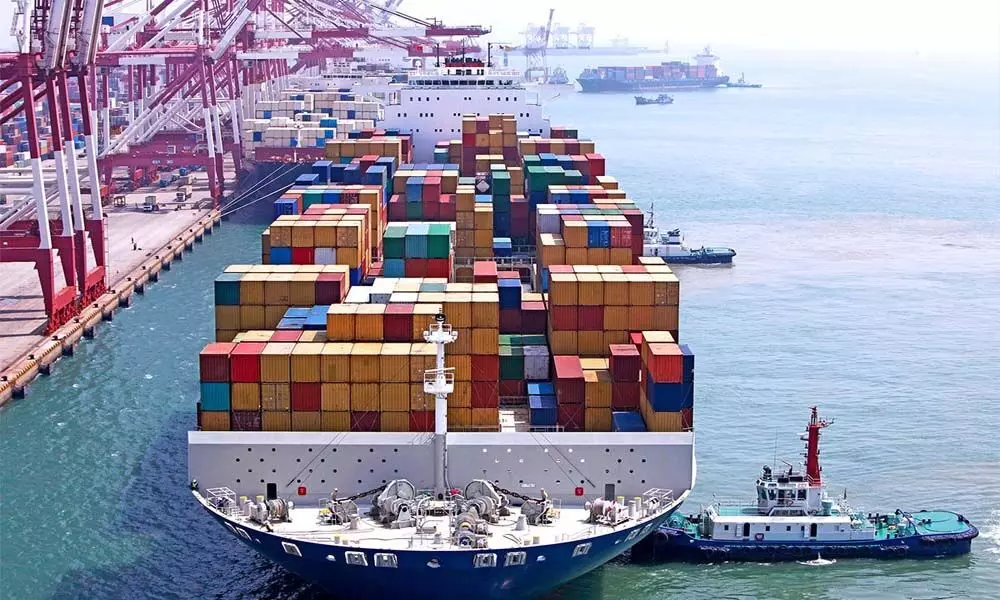Are merchandise exports drifting into goldilocks phase?
Certain agri-based and labour-intensive products like residues and wastes from food industries, animal fodder, coffee, tea, mate and spices, carpets and footwear have exited the export list
image for illustrative purpose

India's merchandise exports in Apr-July period of 2021-22 fiscal were $130.53 billion, an increase of 73.51 per cent over $75.22 billion in Apr-July period of 2020-21 and an increase of 21.82 per cent over $107.15 billion in Apr-July 2019-20. For this fiscal, the growth is broad-based and has been led by engineering goods, petroleum products, gems and jewellery, textiles and garments and organic and inorganic chemicals. Over the years, the biggest contribution has been of the petroleum products. In FY97 their percentage share in overall exports was around 1.5 per cent and this increased to around 21 per cent in FY13 and FY14, a report by SBI economists say.
However, their share declined to nine per cent in FY21 as crude oil prices collapsed before recovering to 14 per cent in current fiscal with the domino impact of jump in crude prices. Thus, the impact of international crude oil prices has always been a big factor in the way India's crude oil exports. As the world slowly moves towards cleaner sources of fuel, India needs to chart a plan to gradually bring its share down. This can only be possible if other manufactured exports improve, it added.
"If we look at the compositional shift, then over the last 25 years, the top 20 HS-2 categories accounted for around 74-80 per cent of the total exports, thus showing that overall, the export basket composition has remained fairly stable over the years. Certain agri-based and labour-intensive products like residues and wastes from food industries, animal fodder, coffee, tea, mate and spices, carpets and footwear have exited the export list. Meanwhile, certain items like Aluminium and articles thereof and Ships, Boats and floating structures exports have grown rapidly and are now part of the top exports," Soumya Kanti Ghosh, chief economic advisor, SBI group, said.
There are certain other products, which have shown rapid growth, but their share in overall exports is still very low as they started from a very low base. These include items like fur skins and artificial fur, arms and ammunition, furniture, aircraft and space craft and zinc and its articles, he added.
The other major manufactured products which started with a good base, like chemicals and pharmaceuticals, electrical and mechanical machinery and appliances, vehicles, articles of iron and steel, plastics have all grown fairly steadily and increased their share in the overall exports. However, there is no big segment which has shown such growth as petroleum sector had done in the past. In a bid to make exports more competitive, India has recently launched Production Led Incentive scheme for sectors such as electronics, pharmaceuticals, food products, white goods, cells, etc. The sectors are well-chosen as they display a lot of potential. However, there are a few more sectors which also display potential which include ships and boats, aircrafts and ceramics and focus on these can yield good results. However, the study goes on, it has to be kept in mind that primary engine of growth for India remains domestic consumption and unless that improves it is difficult for India to achieve sustained growth. For the 18-year period ended FY21, the weighted contribution of exports was 28 per cent, while that of consumption was 69 per cent. For the five-year period ended FY08, the weighted contribution of exports was 39 per cent and that of consumption was 63 per cent, implying that both exports and domestic consumption propelled India's growth. In contrast, for the seven-year period ended FY21, the weighted contribution of exports was seven per cent per cent while that of consumption was 71 per cent, including the years where contribution of exports were negative and domestic consumption held centre stage.

